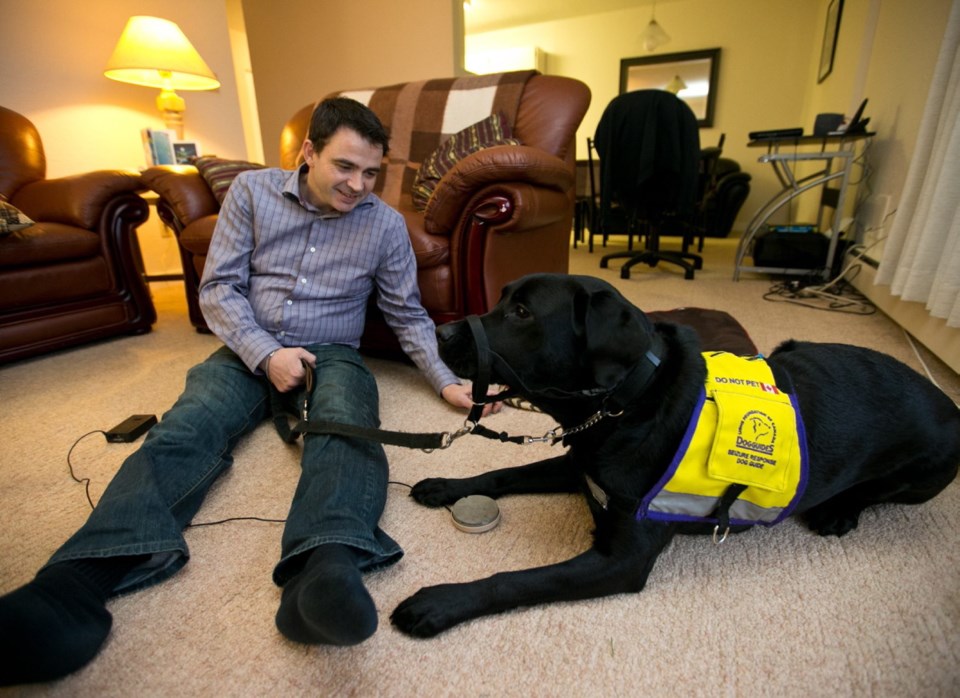Multiple sclerosis and epilepsy stole Robert Gill’s career and his freedom of movement when he had to give up his driver’s licence.
But a Labrador retriever named Naveed, a service dog trained to help Gill when he has a seizure, gives Gill the ability to walk down the street without worry, ride a bus and live on his own in his James Bay apartment.
“I get independence,” said the 41-year-old former restaurant manager who now lives on a disability pension.
“Without the service animal, I couldn’t even live on my own,” Gill said. “I would have to go into some kind of home where people could check on me to make sure I wasn’t in any kind of seizure.”
Two-year-old Naveed is trained to recognize when Gill is in a seizure.
If they are at home, she will step on an alarm button. It’s about the size and shape of a hockey puck and pressing it alerts ambulance and Victoria Fire Department paramedics.
If a seizure hits during a walk outside, Naveed will stay by Gill’s side and bark until help comes. She is even trained to accompany him in the ambulance to the hospital, where the two can be separated.
“She can go anywhere I can go in Canada, except for food preparation areas and intensive-care zones.”
Naveed is one of more than 150 dogs now graduating as service dogs from the Lions Foundation of Canada Dog Guides. The foundation operates two training centres in Canada, in Oakville, Ont., and Breslau, Ont.
In the past year, 153 service dogs graduated, the most ever, said Natalie Moncur, spokeswoman for the Lions Foundation of Canada Dog Guides. The coming year looks to be even more successful.
Four breeds — Labrador and golden retrievers, and standard and miniature poodles — are chosen as service dogs for their intelligence, stable characteristics and willingness to work.
These breeds can be trained as guides for the blind or visually impaired, as hearing dogs to assist people with deafness, as service dogs for people with physical disabilities, as seizure-response dogs, for autism assistance and as diabetic alert dogs.
“Most of our dogs provide an extra level of safety,” Moncur said in a telephone interview from Oakville.
Gill said he was diagnosed with multiple sclerosis in 2002. It often leaves him feeling fatigued.
About six years ago, he suffered his first epileptic seizure. It was a severe seizure lasting 30 minutes before help arrived. And when it did, doctors induced a coma and kept him unconscious for three days.
Since then the attacks, always severe, come about every two or three months.
About four years ago, however, Gill applied and received approval from the Lions Foundation of Canada Dog Guides for a service dog.
That dog, Starsky, was his first and the two were together for about out four years before Starsky developed arthritis. A fundraising drive paid for a $2,500 operation to remove a bone spur from his leg, but Gill eventually decided to let Starsky go.
“He now lives with another family and enjoys a life of swimming and doing whatever normal dogs do,” Gill said.
He and Naveed were paired up in June and the two have quickly become close. “She’s a pretty cool dog,” he said.
Gill said if there is anything he wants people to understand it is that service animals like Starsky and Naveed are working dogs. They are not pets.
People see the specialized headgear fitting partially over the dog’s nose and believe it’s a muzzle. It’s not. It’s a harness, also called a halti, providing closer control to keep the dog focused.
Also, too many people want to pet service dogs, which is a bad idea. Service animals are trained to concentrate on their owners, and affection from another person is an unwelcome distraction.
Just about every day he is outside, Gill said he talks to people about the boundaries to respect around a service dog.
He said the importance of the animal’s single-minded devotion was drilled into him during the three weeks of training he received on how to handle a service dog.
“It was, ‘This your dog, nobody pets it but you. Nobody interacts with it but you. Nobody walks it but you,’ ” Gill said.
There is only one other person whom Gill trusts around Naveed and that’s his girlfriend. Her father was legally blind and had a seeing-eye dog, so she understands the boundaries around service animals.
“If I go into hospital for three or four days I would leave my service dog with my girlfriend, but she’s the only one,” Gill said.
To learn more about the Lions Foundation of Canada Dog Guides, go to dogguides.com.



